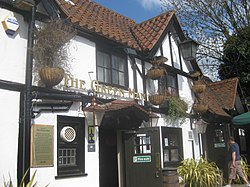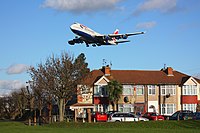Hatton, Middlesex
| Hatton | |
| Middlesex | |
|---|---|
 The Green Man pub in Hatton | |
| Location | |
| Grid reference: | TQ095755 |
| Location: | 51°28’4"N, 0°25’21"W |
| Data | |
| Post town: | Hounslow, Feltham |
| Postcode: | TW6, TW14 |
| Dialling code: | 020 |
| Local Government | |
| Council: | Hillingdon / Hounslow |
| Parliamentary constituency: |
Feltham and Heston |
Hatton including Hatton Cross is a small, semi-urbanised village in Middlesex, on the south-eastern edge of Heathrow Airport and straddling the A30 road.
The village once had attractive rural houses with gardens, one having been built by Edward III and visited by Richard II, another centuries later having been the home of Sir Frederick Pollock, 1st Baronet through to his grandson, Sir Frederick Pollock, the 3rd Baronet, first cousin of the first Viscount Hanworth resident at much larger Hanworth Park.
The area was for many decades a notorious place for highway robberies and its surviving old inn, The Green Man has a hiding-hole behind the chimney. A nearby road is named Dick Turpin Way accordingly.
Hatton grew up as a hamlet of Bedfont, from which it is separated by a field and local sports facilities. It is flanked to the north and north-west by major roads, depots, warehouses, hotels and parking areas associated with Heathrow Airport which take up the north of the locality, leading to the consolidation of that area into Hillingdon since 1994. It is joined, south, by Bedfont and North Feltham and to the east by the River Crane, over which is Hounslow. The settled part is the interior and one side of a triangle south of the dualled A30. Further south a line of houses continues which faces Hounslow Urban Farm and is then engulfed by naming into the North Feltham Trading Estate such as Feltham Ambulance Station beside the farm. The current naming has eaten into what was once squarely Hatton, just as Heathrow has from the opposite direction.
Name
Hatton's name comes from the Old English Hæþtun, meaning "heath farmstead"; until 1819 its cultivated area and small residential gardens were surrounded by heath.
History
In 1086 Roger de Montgomery, Earl of Arundel, held one and a half hides in Hatton, which in the reign of King Edward the Confessor had been held by two sokemen, vassals of Albert of Lorraine. This land belonged to the earl's manor of Colham, in which it probably became merged. A second entry in the Domesday Survey relates to a still smaller estate in Hatton, which was held by Walter Fitz Other, and which had been held formerly by two vassals of Azor. It is probable that this land became merged in the Windsor Manor of East Bedfont, and was possibly granted to Hounslow Priory with the rest of that property. The priory certainly held land in Hatton in 1382, and in 1599 it was granted, as land formerly belonging to Hounslow, to Sir Michael Stanhope, and from that time descended with the manor of East Bedfont.
Edward III of England seems to have built a house at Hatton, which was known as Hatton Grange. Richard II held this of the priory of Hounslow at a yearly rent of 50 shillings.
In 1911, the hamlet of Hatton lay in the level country to the east of Staines two miles to the north-east of East Bedfont. Its street formed a convergence of byways radiating from the south toward the Staines Road from the other side towards the parallel Bath Road, and for this reason it is said to have been a favourite haunt of highwaymen. It was always buffered, east, by the gorse, dry grass, brambles and silver birches of Hounslow Heath, and both main roads were easily accessible from the old inn, The Green Man where the hiding-hole behind the chimney is evident.[1]
Two fairs, held respectively about 7 May at Bedford and 14 June at Hatton, were abolished by the Home Secretary on the representation (petitioning) of the Justices of the Peace (local magistrates) in April 1881. It does not appear how long it had been the custom to hold them.[1]
There was in 1911 a Baptist chapel in Hatton, and a licensed mission room of the Church of England.[1]
Effects of London Heathrow Airport

Hatton has a varied collection of industrial buildings providing ancillary services to Heathrow Airport. The east of Hatton is noisy due to aircraft frequently landing or taking off and at Myrtle Avenue has a well-cut green for spotting of aeroplanes.
About the village
In Hatton Green is a pub-restaurant "The Green Man". Close by is the Hounslow Urban Farm.[2]
The larger village centre is known as Hatton Cross, which has a railway station of the same name. Here are found the main shops, and also a large hotel, The Atrium.
Hatton no longer has a church; its Baptist Chapel/Anglican Mission Room was converted for office use in 2000. There are fewer houses here than in former generations; mainly semi-detached houses or maisonettes built between the 1930s and the 1950s. Several older properties remain in Green Man Lane, including the old Manor house (now the headquarters of a car leasing company) and two other 18th century dwellings. The 17th century blacksmith's yard and buildings have been converted into a family home.
East of Hatton is a large lake, which used to be a sand and gravel quarry. It is over 500 yards long, but divided by a new road, The Causeway.
As eathrow Airport has grown, its eastern estates including car parks and a hotel on the Bath Road occupy a large minority of Hatton's land — all of Hatton north of the A30 road (Great South-West Road).
The line of Staines Road is a Roman road.
References
- ↑ 1.0 1.1 1.2 A History of the County of Middlesex - Volume 2 pp 309-314: Spelthorne Hundred: East Bedfont with Hatton (Victoria County History)
- ↑ Hounslow Urban Farm